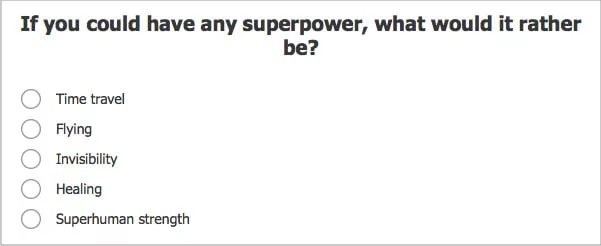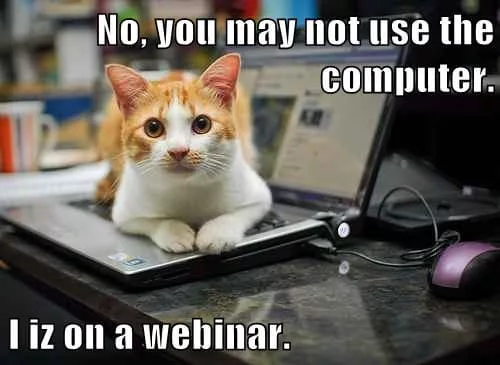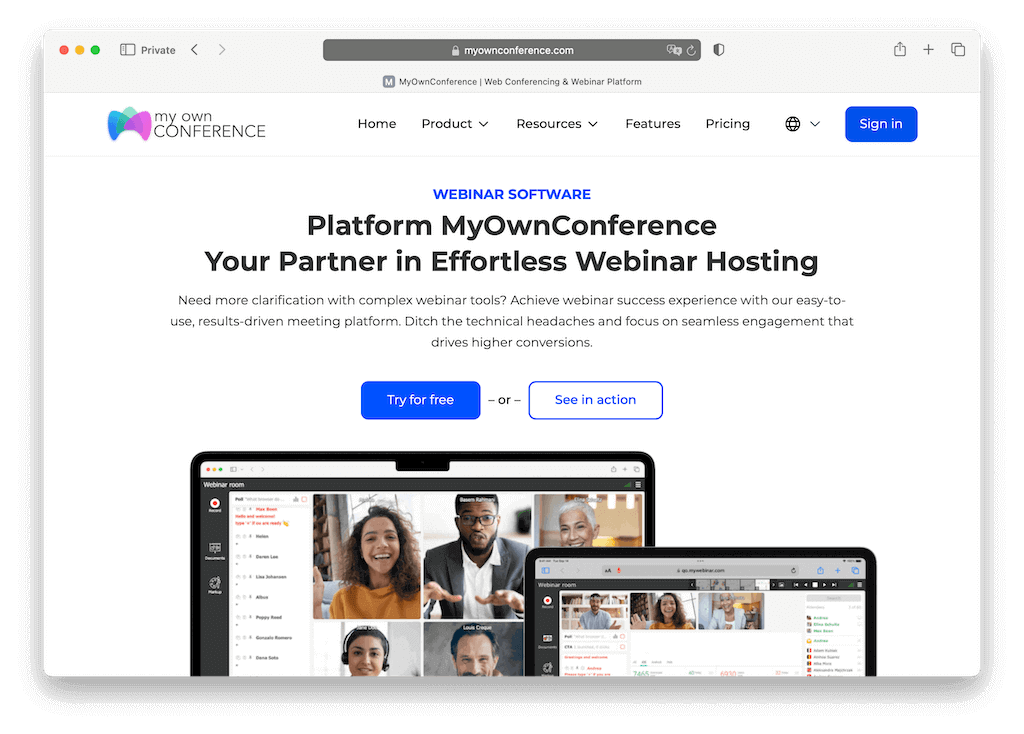
The effectiveness of webinars depends on the level of interest from the audience. An interactive webinar keeps participants engaged by encouraging real-time communication, feedback, and participation.
Enhance Engagement with Interactive Webinar Strategies
Summarize with
Table of contents
- Enhance Engagement with Interactive Webinar Strategies
This approach helps create a more meaningful and memorable experience for everyone involved.
What makes a webinar interactive?
The main mistake many speakers make is organizing their speech like a lecture where they simply convey information and don’t worry about the engagement and interaction of their listeners. They talk too much and don’t interact with the listeners. This way, it won’t be possible to keep the attendees interested.
However, it is more reasonable to show fewer data and be more mindful of your audience to make a webinar interactive and exciting.
In this regard, you can follow several principles and take several actions to make listeners more curious and interested.
1. Frequent changes
Human nature is very prone to get bored easily and quickly. This trend is especially pronounced in recent years. The more content we get, the less time people dedicate to processing it.
The brain needs novelty to stay sharp. This is why speakers should make frequent changes in their presentation. For example, a speaker may just alternate formats such as following a lecture by a discussion, survey, etc.
But it’s good to keep the rule of a “golden middle.” Changing slides or format too frequently may be irritating and inefficient, as the listeners will find it hard to follow the speaker’s line of thought. As a result, viewers will quickly lose interest.
When it comes to your presentation style, there are many ways to make your webinar more engaging. Varying your rhythm and pace while speaking helps keep the audience focused and interested. This approach makes it less likely for attendees to lose attention or become bored. In an interactive webinar, it is especially important to maintain a natural and confident tone. Avoid sounding too theatrical, but do show genuine interest in your topic. Participants appreciate a host who is well-prepared and enthusiastic. To make your session even more compelling, consider sharing a few short stories or personal anecdotes. People connect with real-life experiences, and this kind of storytelling can make your interactive webinar more relatable and memorable.
Keep learning:
2. Exercises and challenges
People accept information better if they are actively engaged in the process. Exercises that challenge the audience are an excellent way of making a webinar interactive and interesting.
Challenges activate the brain and increase its perceptiveness. What’s more, people digest information in practice better, i.e., based on a simulated situation.
The challenge does not have to be significant: you do not want to stress out your participants. Educators on Coursera would usually include a small test every 5-10 minutes to check if people are paying attention. You can adopt the same approach in your live webinar.
When doing exercises and meeting challenges accordingly with the demonstrated material, listeners are more likely to understand and adopt new ideas. As a consequence, the defined goal of a webinar is more probable to be achieved.
3. Questions (surveys and polls, etc.)
It’s a great idea to ask questions and even make a survey or a poll for the audience. Here is why questions matter.
They help speakers find out the impressions of their listeners
It’s essential to know the listeners’ opinions about the information provided and adjust the flow of a webinar accordingly. If your viewers say they are bored, perhaps it’s time to tell them a personal anecdote or show a funny picture.
They improve overall communication between speakers and listeners
Let’s say you hold a webinar about coding. It’s a complex topic, and it’s only natural for people to feel overwhelmed and confused. If you don’t take timely measures, you may lose your audience altogether.
So it only makes sense to pause your presentation regularly and ask your participants if they need any help.
It’s also a good idea to invite a moderator who can help you single out your viewers’ most frequent questions and concerns.
They help recapture attention and bolster engagement
The traditional way to engage your audience and recapture their attention would be an ice-breaker. You can ask general questions such as where they are from or if they prefer tea or coffee and make more industry-specific queries.

Try addressing one person in particular. This will make your webinar room feel more like a real classroom since by singling out one participant, you let your viewers know that you can see and hear them.
This way, they’ll be less tempted to check their Instagram frequently since they know they might get caught.
In addition, by talking to your participants directly, you decrease the emotional distance between you and your audience, boosting engagement. Try not to use phrases used by many hosts, for example, if attendees have any questions. Instead, talk to them directly, ask relevant questions. It’s also worth trying to create a relationship between you and the attendees. Ask for their opinion, allowing them to speak on the microphone (if the group is small). It will make them feel like they’re important to you, which will make your webinars more attractive.
You can also try to challenge your audience to make them think. What does this mean? Say something that surprises them. For example, you might claim that smartphones will completely replace computers within five years, even though that is obviously not true. After that, ask what they think about your statement. This approach helps make people more active and keeps them engaged in the discussion.
Are you interested in hosting an online meeting? Register at web conferencing platform MyOwnConference and host online meetings for 5 attendees for free.
4. Music
There is no doubt that speakers should take certain actions to improve listeners’ attention to increase the overall efficiency of webinars. Music is one of the most effective tools in terms of raising productivity and activating the brain.
Moreover, music is a great way to make a little time-out or calm a situation (for example, in case of heated discussions).
An appropriate piece of music may make the atmosphere of an online meeting more comfortable, informal, and friendly. In addition, it creates associations and contributes to a better perception of the information.
It’s interesting that video can generate 12 times more shares (see 12 times more engagement) than text and video combined. It is a content crime not to use this medium in your presentation.
5. Video
Here are some of the ways you can include video in your webinar.
To start a discussion
While theoretical knowledge may be exciting for someone, most people come to a webinar to learn something practical. They want to interact with the new ideas, not just stuff them into their heads. After all, if your participants just wanted to learn something, they could simply open Wikipedia.
Instead of going for hours about the benefits of 3D marketing and augmented reality, you can show a video and provide a practical example of this type of advertising.
You can then ask your viewers to share their thoughts on a given case. Do they have any ideas on how to improve a particular marketing campaign? Position your viewers in an expert role, but do not forget to add your own critique as well.
To test participants
If you are holding a webinar on rhetoric, ask your participants to watch a video and spot the logical fallacies committed by the speaker. Let them type their answers in chat and give a shout-out to those who guessed correctly.
Your participants can listen to the audio and scroll their feed at the same time, which is not the case with video. The video makes your viewers more likely to devote their attention solely to your webinar and interact with you and the others.
Video increases the intractability of your webinars since users are encouraged to watch carefully, do tests and share their opinions on the things just witnessed.
6. Chat
Webinar services almost always include a chat. This is justified since a webinar is more interactive if listeners have a chance to exchange comments and ideas about your webinar. They may share examples from their own experience and ask questions without interrupting the entire process.
Many newbie webinar creators make the mistake of only paying attention to the viewers’ questions. And while those are important, you should also recognize those users who simply share their positive experience with you. This helps build relationships beyond the traditional teacher-student model.
It will also inspire other participants to share their comments and interact with you since they hope for the same acknowledgement.
7. Jokes and humor

It’s impossible to overvalue humor:
- A good joke boosts listeners’ mood.
- It improves the webinar atmosphere and helps each participant relax.
- It activates brain work, consequently increasing webinar productivity.
But most importantly, humor adds authenticity to your performance and connects you and your audience on a deeper level.
The encryption theory claims that humor reflects shared experiences, helping people spot the insiders and the outsiders. So if you want to be on the same wavelength with your viewers, try adding some humor into your speech.
8. Two and up to 10 speakers
The influence of various speakers may differ considerably. Some of them talk more emotionally, and some are more logical. If a webinar has two or more speakers, the information is provided from different points of view and in a diverse manner, so speakers complement each other.

Let your speakers have a panel discussion. An engaging dialogue is like a tennis match: your viewers simply won’t be able to look away. However, make sure to moderate it properly since when views clash, a conflict arises.
You may also invite surprise guests to your event. However, this idea comes with a caveat: would you sacrifice marketing for the sake of a quick attention grab? After all, more viewers will sign up for your webinar if you announce interesting speakers in advance.
As you can see, passionate speakers definitely make a webinar interactive, enhance collaboration and teamwork.
9. Competitions and giveaways
An excellent way to ensure that your participants stay glued to their screens is to organize a small competition or raffle.
Mention that your viewers can take a small test at the end of a webinar and win a prize if they answer all questions correctly. This will encourage them to remain attentive and interact with you and other participants.
The prize does not have to be massive. It can be as simple as a free pass to your next webinar or perhaps a ticket to a personal meeting with you.
10. Personal stories
It’s okay to be afraid of getting personal with your viewers. However, storytelling is one of the most powerful tools for engagement and interaction, and you should not disregard it completely.
You don’t need to get into gruesome details about your struggles if you are uncomfortable. Reveal what you believe best captures the essence of your brand and personality. Take your viewers on a journey from point A (having a dream) to point B (becoming who you are today).
Such an approach will give your participants an extra incentive to stay engaged and interact with your webinar.
11. Prepare for the unexpected
Each webinar should be well-thought-out. Keep in mind that participants differ in their interests and characters. Some think positively, and others are biased and negative.
Therefore, speakers should have several schemes in their reserve to resolve issues during a presentation, answer questions, defuse a situation and make the process interesting for each participant.
All in all, a successful webinar is an interactive webinar. And the key to success is demonstrating a positive attitude to the audience.
Assure them that you care about their opinions. Unsympathetic presenters are never outstanding. Inspire and engage your audience, and you will definitely achieve your webinar goals.
What will make you less stressed is also the good old brainstorming. Think of the questions attendees could ask you during the webinar. Remember that there’s no way to know everything, but if you know what some possible questions are, you’ll get the opportunity to prepare answers.
Remember that deep knowledge of the topic is essential. You need to be well prepared and confident in the material you present. Simply reading from notes will not engage your audience and may cause them to lose interest quickly. In an interactive webinar, participants expect more than just a lecture. They look forward to dynamic engagement, real-time responses, and meaningful interaction. To hold their attention, speak naturally, use examples, ask questions, and encourage participation throughout the session.
Summary
In conclusion, when you consistently include interactive elements and adjust your presentation based on how participants respond, you turn a seminar-style event into a lively experience where learners feel connected, appreciated, and engaged. Attendees will not stay interested with slides alone, so it is important to use polls, chats, short videos, and personal stories to change the pace, encourage participation, and keep the energy level high. Prepare for the unexpected by having backup tools and alternative activities ready, which allows you to switch smoothly if engagement starts to drop. This approach helps you maintain momentum and reach your goals. In the end, the most successful webinars are the ones where the audience feels heard, included, and appreciated. When that happens, your message does more than just reach people because it truly stays with them during an interactive webinar.
FAQ
You should change formats regularly but not too frequently. For example, after about 10-15 minutes of lecture you might switch to a poll or discussion. If you shift too often, participants might lose the thread. The key is balance.
You can ask participants to solve a quick problem related to the topic, do a mini‑case study in small groups, or answer a practical quiz. The challenge should not be overwhelming but stimulating enough to make people think and apply what they just heard.
You can invite specific questions, ask for short comments, praise good contributions, and moderate so the chat remains relevant. At the same time set expectations (for example, ask people to post brief thoughts or questions rather than long monologues) so the chat remains constructive.
Humor and personal stories help humanize the speaker and reduce emotional distance. They make the webinar more relatable and break tension. When participants feel the speaker is a real person, they are likelier to respond and engage.
You should have backup plans, like extra questions, alternative interactive elements, prompts, or surprise polls. Also anticipate what participants might ask and prepare responses. If engagement is low, prompt discussion, ask direct questions, or shift format to a more interactive mode.
An expert behind the simplified online meeting and webinar software platform, MyOwnConference. In today’s flexible work environment, Dan offers invaluable life hacks, in-depth reviews, and savvy tips for organizing, promoting, and excelling in virtual conferences and webinars.











